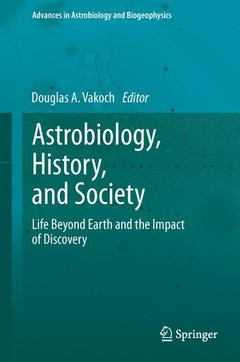Description
Astrobiology, History, and Society, 2013
Life Beyond Earth and the Impact of Discovery
Advances in Astrobiology and Biogeophysics Series
Coordinator: Vakoch Douglas A.
Language: English
Subjects for Astrobiology, History, and Society:
Publication date: 02-2015
375 p. · 15.5x23.5 cm · Paperback
Publication date: 06-2013
375 p. · 15.5x23.5 cm · Hardback
Description
/li>Contents
/li>Comment
/li>
This book addresses important current and historical topics in astrobiology and the search for life beyond Earth, including the search for extraterrestrial intelligence (SETI). The first section covers the plurality of worlds debate from antiquity through the nineteenth century, while section two covers the extraterrestrial life debate from the twentieth century to the present. The final section examines the societal impact of discovering life beyond Earth, including both cultural and religious dimensions. Throughout the book, authors draw links between their own chapters and those of other contributors, emphasizing the interconnections between the various strands of the history and societal impact of the search for extraterrestrial life.
The chapters are all written by internationally recognized experts and are carefully edited by Douglas Vakoch, professor of clinical psychology at the California Institute of Integral Studies and Director of Interstellar Message Composition at the SETI Institute.
This interdisciplinary book will benefit everybody trying to understand the meaning of astrobiology and SETI for our human society.
Part I. The Early Extraterrestrial Life Debate.- Chapter 1. The Extraterrestrial Life Debate from Antiquity to 1900.- Chapter 2. Early Modern ET, Reflexive Telescopics, and Their Relevance Today.- Chapter 3. Extraterrestrial Life as the Great Analogy, Two Centuries Ago and in Modern Astrobiology.- Chapter 4. Hegel, Analogy, and Extraterrestrial Life.- Chapter 5. The Relationship Between the Origins of Life on Earth and the Possibility of Life on Other Planets: A Nineteenth-century Perspective.- Chapter 6. Pioneering Concepts of Planetary Habitability.- Part II. The Modern Extraterrestrial Life Debate.- Chapter 7. The Twentieth Century History of the Extraterrestrial Life Debate: Major Themes and Lessons Learned.- Chapter 8. The Creator of Astrobotany, Gavriil Adrianovich Tikhov.- Chapter 9. Life Beyond Earth and the Evolutionary Synthesis.- Chapter 10. The First Thousand Exoplanets: Two Decades of Excitement and Discovery.- Chapter 11. Extraterrestrial Life in the Microbial Age.- Part III. Societal Impact of Discovering Extraterrestrial Life.- Chapter 12. The Societal Impact of Extraterrestrial Life: The Relevance of History and the Social Sciences.- Chapter 13. Cultural Resources and Cognitive Frames: Keys to an Anthropological Approach to Prediction.- Chapter 14. The Detection of Extraterrestrial Life: Are We Ready?.- Chapter 15. Impact of Extraterrestrial Life Discovery for Third World Societies: Anthropological and Public Health Considerations.- Chapter 16. Impossible Predictions of the Unprecedented: Analogy, History, and the Work of Prognostication.- Chapter 17. Mainstream Media and Social Media Reactions to the Discovery of Extraterrestrial Life.- Chapter 18. Christianity’s Response to the Discovery of Extraterrestrial Intelligent Life: Insights from Science and Religion and the Sociology of Religion.- Chapter 19. Would the Discovery of ETI Provoke a Religious Crisis?.- Index.




